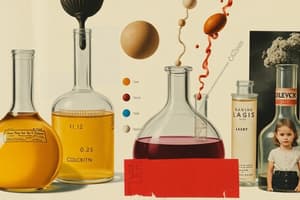Podcast
Questions and Answers
Which state of matter has a definite shape and volume?
Which state of matter has a definite shape and volume?
- Liquid
- Solid (correct)
- Plasma
- Gas
What term describes the process when a gas turns into a liquid?
What term describes the process when a gas turns into a liquid?
- Sublimation
- Condensation (correct)
- Vaporization
- Melting
Which of the following properties is true for liquids?
Which of the following properties is true for liquids?
- They take the shape of their container but have a definite volume. (correct)
- They have no definite shape or volume.
- They have a definite shape and volume.
- They are composed of particles that are far apart.
Which of the following states of matter is NOT considered a fluid?
Which of the following states of matter is NOT considered a fluid?
What happens when a solid changes directly into a gas?
What happens when a solid changes directly into a gas?
What is an example of a mechanical mixture?
What is an example of a mechanical mixture?
Which of the following best describes a colloid?
Which of the following best describes a colloid?
In a sugar-water solution, what is the solute?
In a sugar-water solution, what is the solute?
Which type of mixture has components that settle slowly after mixing?
Which type of mixture has components that settle slowly after mixing?
What determines if solid materials will dissolve in a solvent?
What determines if solid materials will dissolve in a solvent?
What defines a saturated solution?
What defines a saturated solution?
Which of the following materials is classified as soluble?
Which of the following materials is classified as soluble?
What separation method is NOT used for a salt and water mixture?
What separation method is NOT used for a salt and water mixture?
How does the viscosity of a liquid affect its flow rate?
How does the viscosity of a liquid affect its flow rate?
What is the formula for calculating density?
What is the formula for calculating density?
What is the correct order of the states of matter from most dense to least dense?
What is the correct order of the states of matter from most dense to least dense?
What phenomenon explains why materials tend to rise or float in a fluid?
What phenomenon explains why materials tend to rise or float in a fluid?
Why do cargo ships float even though steel is denser than water?
Why do cargo ships float even though steel is denser than water?
How does a hydrometer measure liquid density?
How does a hydrometer measure liquid density?
What is the formula to calculate pressure?
What is the formula to calculate pressure?
What is the force created by a pressure of 76 Pa over an area of 4 m²?
What is the force created by a pressure of 76 Pa over an area of 4 m²?
What is the area when a pressure of 105 Pa is created with 21 N of force?
What is the area when a pressure of 105 Pa is created with 21 N of force?
Why can gases be compressed easily compared to liquids?
Why can gases be compressed easily compared to liquids?
What effect does applying a force to a gas have?
What effect does applying a force to a gas have?
Why are liquids considered incompressible?
Why are liquids considered incompressible?
What occurs when a force is applied to a liquid?
What occurs when a force is applied to a liquid?
What is the primary function of a hydrometer?
What is the primary function of a hydrometer?
Which scenario best illustrates an unbalanced force?
Which scenario best illustrates an unbalanced force?
What happens to atmospheric pressure as altitude increases?
What happens to atmospheric pressure as altitude increases?
What characterizes a balanced force in terms of pressure?
What characterizes a balanced force in terms of pressure?
What causes aerosols to exit their containers with great force?
What causes aerosols to exit their containers with great force?
Which of the following best describes the role of the container in aerosol functioning?
Which of the following best describes the role of the container in aerosol functioning?
What is the primary reason aerosols can be effectively used for delivery in various applications?
What is the primary reason aerosols can be effectively used for delivery in various applications?
Which aspect of the gas particles contributes to the effectiveness of aerosols?
Which aspect of the gas particles contributes to the effectiveness of aerosols?
What would happen if the walls of an aerosol container were not strong?
What would happen if the walls of an aerosol container were not strong?
Flashcards are hidden until you start studying
Study Notes
States of Matter
- There are three states of matter: solid, liquid, and gas.
- Solids have a definite shape and volume.
- Liquids take the shape of their container and have a definite volume.
- Gases take the shape and volume of their container.
- Fluids are substances that flow; Liquids and gases are considered fluids.
- Condensation is when a gas turns into a liquid.
- Freezing is when a liquid turns into a solid.
- Sublimation is when a solid turns into a gas.
- Vaporization is when a liquid turns into a gas.
- Deposition is when a gas turns into a solid.
- Melting is when a solid turns into a liquid.
Mixtures
- Mechanical Mixtures are heterogeneous mixtures where the components are easily distinguishable (salad, trail mix).
- Suspensions are heterogeneous mixtures where particles settle slowly after mixing (paint, blood).
- Colloids are heterogeneous mixtures where particles do not settle (milk, gelatin).
- Solutions are homogeneous mixtures where no settling occurs (vinegar, saltwater).
Dissolving Materials
- Soluble materials dissolve to form a solution.
- Insoluble materials do not dissolve.
- The strength of attraction between solvent and solute particles determines whether a material will dissolve.
Sugar-Water Solution
- The solute in a sugar-water solution is sugar.
- The solvent in a sugar-water solution is water.
Separation Methods
- Sand and Water Mixture:
- Evaporation
- Filtration
- Sifting
- Salt and Water Mixture:
- Evaporation
- Distillation
- Woodchip and Water Mixture:
- By hand/Floatation
Viscosity and Flow Rate
- Viscosity is a measure of a fluid's resistance to flow.
- Flow rate is the speed at which a fluid moves.
- Increased viscosity leads to decreased flow rate.
- Decreased viscosity leads to increased flow rate.
Density
- Density is a measure of mass per unit volume.
- Formula for density: $D = \frac{M}{V}$
- Solids are the most dense state of matter.
- Liquids are moderately dense.
- Gases are the least dense state of matter.
Buoyancy
- Buoyancy is the tendency of an object to float or rise in a fluid.
- Buoyancy and density are related through the hydrometer (an instrument that measures liquid density).
- A hydrometer floats higher in liquids with higher density and sinks lower in liquids with lower density.
Pressure
- Pressure is the force applied per unit area.
- Formula for pressure: $P = \frac{F}{A}$
Compressibility
- Gases are compressible because their particles can be squeezed closer together.
- Liquids are incompressible because their particles are already close together.
Balanced and Unbalanced Forces
- Balanced forces occur when forces are equal and opposite, resulting in no net movement.
- Unbalanced forces occur when forces are unequal, resulting in movement.
Atmospheric Pressure
- Atmospheric pressure decreases as altitude increases, due to fewer air particles pressing down.
Aerosols
- Aerosols work by using high-energy gas particles confined in strong-walled containers.
- When released through openings, the gas particles exit with great force.
Studying That Suits You
Use AI to generate personalized quizzes and flashcards to suit your learning preferences.




